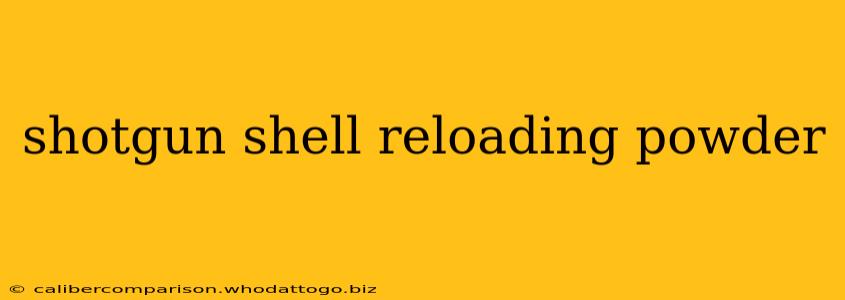Reloading your own shotgun shells can be a rewarding and cost-effective hobby, offering significant savings over commercially loaded ammunition. However, understanding shotgun shell reloading powder is crucial for safety and optimal performance. This guide delves into the nuances of selecting, handling, and using powder for your shotgun reloading projects.
Choosing the Right Shotgun Powder
Selecting the appropriate powder is paramount. The wrong powder can lead to dangerous over-pressure, under-pressure (resulting in unreliable function), or even damage to your firearm. Several factors influence your choice:
1. Shot Size and Weight:
The weight of your shot significantly impacts the required powder charge. Heavier shot necessitates a larger powder charge to achieve adequate velocity. Consult your reloading manual for specific data based on your chosen shot size and weight. Never deviate from recommended loads.
2. Hull Type and Gauge:
Different hull types (plastic, fiber, etc.) and gauges (12, 20, 28, .410) have varying internal volumes. This dictates the maximum powder capacity. Always refer to your reloading manual for load data specific to your chosen hull and gauge.
3. Wad Type:
The wad acts as a cushion between the powder and shot, influencing pressure and velocity. The wad type you select must be compatible with your chosen powder and load data. Using an incorrect wad can severely impact performance and safety.
4. Powder Type:
Several powder types are available, each designed for specific purposes and performance characteristics. Common types include:
- Progressive Burning Powders: These powders burn more slowly, producing a more consistent pressure curve. They are generally preferred for hunting loads where consistent performance is crucial.
- Fast Burning Powders: These burn rapidly, generating high pressure quickly, suitable for target shooting or trap loads.
Always consult the manufacturer's data sheet and a reputable reloading manual for specific load data before attempting any reloading. Improper powder selection can lead to catastrophic equipment failure or serious injury.
Safe Handling and Storage of Shotgun Reloading Powder
Safe handling and storage are critical aspects of shotgun shell reloading. Improper storage can lead to degradation of the powder, potentially affecting performance and safety.
1. Storage Location:
Store powder in a cool, dry, and well-ventilated area, away from heat sources, sparks, and open flames. Keep it separate from ammunition and other flammable materials.
2. Container Integrity:
Ensure that the powder container is tightly sealed to prevent moisture absorption. Damaged containers should be discarded immediately.
3. Static Electricity:
Static electricity can ignite powder. Ground yourself before handling powder and avoid using plastic containers or tools that may build up static charge.
4. Powder Measure:
Use a reliable powder measure, calibrated correctly for your chosen powder. Double-check your powder charges using a scale. Never guesstimate powder charges.
Understanding Powder Data in Reloading Manuals
Reloading manuals provide crucial load data, including:
- Powder Type: The specific brand and type of powder.
- Powder Charge (in grains): The weight of powder to use for a specific load.
- Wad Type: The recommended wad to use with the load.
- Shot Type and Weight: The type and weight of shot to use.
- Pressure: The expected pressure generated by the load.
- Velocity: The expected muzzle velocity of the shot.
Always meticulously follow the instructions in your reloading manual. Deviating from the recommended load data can be extremely dangerous.
Conclusion:
Reloading shotgun shells can be a satisfying experience, but safety must always be the top priority. Careful selection of powder, proper handling, and diligent adherence to loading data are crucial for preventing accidents and ensuring consistent performance. Remember, consulting reputable reloading manuals and manufacturer data sheets is essential before embarking on your reloading journey.

